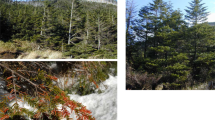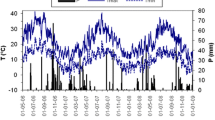Abstract
Hydraulic redistribution (HR), the passive movement of water via roots from moist to drier portions of the soil, occurs in many ecosystems, influencing both plant and ecosystem-water use. We examined the effects of HR on root hydraulic functioning during drought in young and old-growth Douglas-fir [Pseudotsuga menziesii (Mirb.) Franco] and ponderosa pine (Pinus ponderosa Dougl. Ex Laws) trees growing in four sites. During the 2002 growing season, in situ xylem embolism, water deficit and xylem vulnerability to embolism were measured on medium roots (2–4-mm diameter) collected at 20–30 cm depth. Soil water content and water potentials were monitored concurrently to determine the extent of HR. Additionally, the water potential and stomatal conductance (gs) of upper canopy leaves were measured throughout the growing season. In the site with young Douglas-fir trees, root embolism increased from 20 to 55 percent loss of conductivity (PLC) as the dry season progressed. In young ponderosa pine, root embolism increased from 45 to 75 PLC. In contrast, roots of old-growth Douglas-fir and ponderosa pine trees never experienced more than 30 and 40 PLC, respectively. HR kept soil water potential at 20–30 cm depth above −0.5 MPa in the old-growth Douglas-fir site and −1.8 MPa in the old-growth ponderosa pine site, which significantly reduced loss of shallow root function. In the young ponderosa pine stand, where little HR occurred, the water potential in the upper soil layers fell to about −2.8 MPa, which severely impaired root functioning and limited recovery when the fall rains returned. In both species, daily maximum gs decreased linearly with increasing root PLC, suggesting that root xylem embolism acted in concert with stomata to limit water loss, thereby maintaining minimum leaf water potential above critical values. HR appears to be an important mechanism for maintaining shallow root function during drought and preventing total stomatal closure.









Similar content being viewed by others
References
Borghetti M, Edwards WRN, Grace J, Jarvis PJ, Raschi A (1991) The refilling of embolised xylem in Pinus sylvestris L. Plant Cell Environ 14:357–369
Brooks JR, Meinzer FC, Coulombe R, Gregg J (2002) Hydraulic redistribution of soil water during summer drought in two contrasting Pacific Northwest coniferous forests. Tree Physiol 22:1107–1117
Burgess SSO, Adams MA, Turner NC, Ong CK (1998) The redistribution of soil water by tree root systems. Oecologia 115:306–311
Caldwell MM, Richards JH (1989) Hydraulic lift: water efflux from upper roots improves effectiveness of water uptake by deep roots. Oecologia 79:1–5
Caldwell MM, Dawson TE, Richards JH (1998) Hydraulic lift: consequences of water efflux from roots of plants. Oecologia 113:151–161
Cochard H, Breda N, Granier A (1996) Whole tree hydraulic conductance and water loss regulation in Quercus during drought: evidence for stomatal control of embolism. Ann Sci For 53:197–206
Cochard H, Martin R, Gros P, Bogeat MB (2000) Temperature effects on hydraulic conductance and water relations of Quercus robur L. J Exp Bot 51:1255–1259
Cochard H, Coll L, Le Roux X, Ameglio T (2002) Unraveling the effects of plant hydraulics on stomatal closure during water stress in walnut. Plant Physiol 128:282–290
Coleman MD, Bledsoe C, Smit BA (1990) Root hydraulic conductivity and xylem sap levels of zeatin riboside and abscisic acid in ectomycorrhizal Douglas-fir seedlings. New Phytol 115:275–284
Davis SD, Ewers FW, Sperry JS, Portwood KA, Crocker MC, Adams GC (2002) Shoot dieback during prolonged drought in Ceanothus (Rhamnaceae) chaparral of California: a possible case of hydraulic failure. Am J Bot 89:820–828
Domec J-C, Gartner BL (2001) Cavitation and water storage in bole segments of mature and young Douglas-fir trees. Trees 15:204–214
Domec J-C, Gartner BL (2003) Relationship between growth rates and xylem hydraulic characteristics in young, mature and old-growth ponderosa pine trees. Plant Cell Environ 26:471–483
Donovan LA, Linton MJ, Richards JH (2001) Predawn plant water potential does not necessarily equilibrate with soil water potential under well-watered conditions. Oecologia 129:328–335
Donovan LA, Richards JH, Linton MJ (2003) Magnitude and mechanisms of disequilibrium between predawn plant and soil water potentials in desert shrubs. Ecology 84:463–470
Ewers FW (1985) Xylem structure and water conduction in conifer trees, dicot trees, and lianas. Int Assoc Wood Anat Bull 6:309–317
Gholz HL (1982) Environmental limits on aboveground net primary production, leaf area, and biomass in vegetation zones of the Pacific Northwest. Ecology 63:469–481
Girard S, Clement A, Cochard H, Boulet-Gercourt B, Guehl J-M (1997) Effects of desiccation on post-planting stress in bare root Corsican pine seedlings. Tree Physiol 17:429–435
Gladwin J, Kelsey RG, Thies WG (1998) Hydraulic conductivity in roots of ponderosa pine infected with black-stain (Leptographium wageneri) or annosus (Heterobasidion annosum) root disease. Tree Physiol 18:333–339
Gollan T, Turner NC, Schulze ED (1985) The response of stomata and leaf gas exchange to vapor pressure deficits and soil water content in the sclerophyllous woody species Nerium oleander. Oecologia 65:356–362
Hacke UG, Sauter JJ (1995) Vulnerability of xylem to embolism in relation to leaf water potential and stomatal conductance in Fagus sylvatica f. purpurea and Populus balsamifera. J Exp Bot 46:1177–1183
Hacke UG, Sperry JS (2003) Limits to xylem refilling under negative pressure in Laurus nobilis and Acer negundo. Plant Cell Environ 26:303–311
Hacke UG, Sperry JS, Ewers BE, Ellsworth DS, Schafer KVR, Oren R (2000). Influence of soil porosity on water use in Pinus taeda. Oecologia 124:495–505
Irvine J, Law B, Anthoni PM, Meinzer FC (2002) Water limitations to carbon exchange in old growth and young ponderosa pine stands. Tree Physiol 22:189–196
Jackson RB, Sperry JS, Dawson TE (2000) Root water uptake and transport: using physiological processes in global predictions. Trends Plant Sci 5:482–488
Jaquish LL, Ewers FW (2001) Seasonal conductivity and embolism in the roots and stems of two clonal ring-porous trees, Sassafras albidum and Rhus typhina. Am J Bot 88:206–212
Kolb KJ, Sperry JS (1999) Transport constraints on water use by the Great Basin shrub, Artemisia tridentata. Plant Cell Environ 22:925–935
Law BE, Ryan MG, Anthoni PM (1999) Seasonal and annual respiration of ponderosa pine ecosystem. Global Change Biol 5:169–182
Meinzer FC, Grantz DA (1990) Stomatal and hydraulic conductance in growing sugarcane: stomatal adjustment to water transport capacity. Plant Cell Environ 13:383–388
Meinzer FC, Brooks JR, Bucci SJ, Goldstein G, Scholz FG, Warren JM (2004) Converging patterns of uptake and hydraulic redistribution of soil water in contrasting woody vegetation types. Tree Physiol 24:919–928
Mencuccini M (2003) The ecological significance of long-distance water transport: short-term regulation, long-term acclimation and the hydraulic costs of stature across plant life forms. Plant Cell Environ 26:163–182
Moreira MZ, Scholz FG, Bucci SJ, Sternberg LS, Goldstein G, Meinzer FC, Franco AC (2003) Hydraulic lift in a neotropical savanna. Funct Ecol 17:573–581
Oertli JJ (1996) Transport of water in the rhizosphere and in the roots. In: Waisel Y, Eshel A, Kafkafi U (eds) Plant roots. The Hidden Half, New York
Paltineanu IC, Starr JL (1997) Real-time soil water dynamics using multisensor capacitance probes: laboratory calibration. Soil Sci Soc Am J 61:1576–1585
Phillips N, Bond BJ, McDowell NG, Ryan MG (2002) Water flux and canopy conductance in young, mature and old-growth Douglas-fir forests. Tree Physiol 22:205–211
Querejeta JI, Egerton-Warburton LM, Allen MF (2003) Direct nocturnal water transfer from oaks to their mycorrhizal symbionts during severe soil drying. Oecologia 134:55–64
Richards JH, Caldwell MM (1987) Hydraulic lift: substantial nocturnal water transport between soil layers by Artemisia tridentata roots. Oecologia 73:486–489
Saliendra NZ, Sperry JS, Comstock JP (1995) Influence of leaf water status on stomatal response to humidity, hydraulic conductance and soil drought in Betula occidentalis. Planta 196:357–366
SAS (1999) Version 8. SAS Institute, Cary, N.C.
Scholz FG, Bucci SJ, Goldstein G, Meinzer FC, Franco AC (2002) Hydraulic redistribution of soil water by neotropical savanna trees. Tree Physiol 22:603–612
Sperry JS (2002) Hydraulic constraints on plant gas exchange. Agric For Meteorol 104:13–23
Sperry JS, Ikeba T (1997) Xylem cavitation in roots and stems of Douglas-fir and white fir. Tree Physiol 17:275–280
Sperry JS, Saliendra NZ (1994) Intra- and inter-plant variation in xylem cavitation in Betula occidentalis. Plant Cell Environ 17:1233–1241
Sperry JS, Alder FR, Campbell GS, Comstock JP (1998) Limitations of plant water use by rhizosphere and xylem conductance: results from a model. Plant Cell Environ 21:347–359
Tardieu F, Davies WJ (1993) Integration of hydraulic and chemical signaling in the control of stomatal conductance and water status of droughted plants. Plant Cell Environ 16:341–349
Tyree MT, Ewers FW (1991) The hydraulic architecture of trees and other woody plants. New Phytol 119:345–360
Zou C, Sands R, Sun O (2000) Physiological responses of radiata pine roots to soil strength and soil water deficit. Tree Physiol 20:1205–1207
Acknowledgements
Laboratory and field assistance by D. Woodruff, H. Oakes-Miller and A. Burke is greatly appreciated. This work was supported by: PNW 02-JV-1126952-252 from the USDA Forest Service and the US Environmental Protection Agency (EPA). This manuscript has been subjected to the EPA’s peer and administrative review, and it has been approved for publication as an EPA document. Mention of trade names or commercial products does not constitute endorsement or recommendation for use.
Author information
Authors and Affiliations
Corresponding author
Rights and permissions
About this article
Cite this article
Domec, JC., Warren, J.M., Meinzer, F.C. et al. Native root xylem embolism and stomatal closure in stands of Douglas-fir and ponderosa pine: mitigation by hydraulic redistribution. Oecologia 141, 7–16 (2004). https://doi.org/10.1007/s00442-004-1621-4
Received:
Accepted:
Published:
Issue Date:
DOI: https://doi.org/10.1007/s00442-004-1621-4




